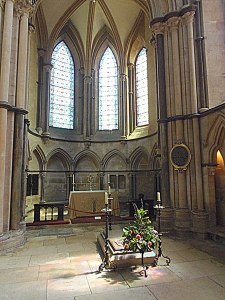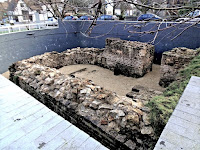This description of Lincoln was written by Adam Stark. He was as critical of the city as some of us are two hundred years later.
"LINCOLN is at present arbitrarily divided into two parts, known by the appellation of Above-hill and Below-hill, though, where this division begins or ends, perhaps none of the inhabitants can determine. The former part is the general residence of the gentry and clergy ; while the latter is mostly inhabited by merchants and tradespeople : the one being, according to the common estimation, considered as the court, and the other as the mercantile part of the city.
"On entering Lincoln, from the London road, the first object that presents itself is the bar-gate, the Norman south gate of the city, guarded on the outside by the Sincil dyke, which runs from west to east, to some distance below the bar, when it turns southward, past the remains of an old tower, built to defend the angle; but at present of no other use than to serve as a shed for cattle to retire to.
"On the west of the road, without Bargate, king Edward erected a beautiful cross(1) to the memory of his queen, Eleanor, who died at Harby, a village about seven miles from Lincoin, and was removed by easy stages to Westminster, there to be interred; the king perpetuating her memory by creating a cross at every spot where the corpse rested ; " with the arms of England, Castile, and Pontoys engraven on it." Of this there are now no vestiges, it having been demolished so early as 1643. The cross at Waltham, still remaining, was erected by him on the same occasion."
"The first object of note within the bar is the church of St. Botolph, which seems here very properly situated, appearing, in this straggling part of the city, like the church of a country village. Some distance, beyond St.Botolph's church, a branch of the Witham. crosses the street, over which are two very inconvenient bridges, disgraceful to the city, and incommodious, if not dangerous, to the passenger. It is surprising there is no attempt at convenience, if improvement is not thought of. , "A little above Gote-bridge," says Leland, "on the east-side of the High street, is a fair guildhall, 'longing to St. Anne's church of the foundation of Burton and Sutton, merchants. A very goodly house, 'longings to Sutton is hard on the north-side of St. Anne's churchyard." By St. Anne's church we are inclined to think that Leland meant St. Andrew's, for there does not appear ever to have been a church dedicated to St. Anne in this city.
"Near this range of buildings stands the Unitarian chapel, a small building, with a burying ground adjoining to it. There is nothing particularly interesting in its interior.
""I heard say," observes Leland, "that the lower part of Lincoln town was all marisch, and won by policy, and inhabited for the commodity of the water. This part is called Wigkerford. "A contraction of this name is yet retained, in the term of Wigford, by which this part is known; the appellation might have its origin from this place having been remarkable for the growth of osiers, or withies, from which the term 'wicker-work' is derived, and perhaps, may have been introduced by the Danes; twigs of osiers or willows being in their language expressed by the word vigre. The other part of the name, ford, needs no comment.
"Behind St. Benedict's church there is a small chapel, where a society of the baptist Connexion meets.
"Between bar-gate and the stone-bow once stood, according to Leland's account, eleven churches, and a great number of religious houses ; but of these even the sites of the greater part are now forgotten. This street, though straight, wide, commodious, and clean, is yet very deficient in beauty : from the want of uniformity in its buildings; from the high roofs and old gables that continually present themselves to the eye, and the lime trees that are here and there planted in rows, each tree cut round the top, so as to form the appearance of a housemaid's mop inverted, or a large cabbage left sticking upon a naked stem. This is the more to be regretted, as these trees, if left in their natural state, would have produced a useful shade, and an ornament as pleasing and agreeable, as that they now form, by the injudicious application of art, is disagreeable.
"After passing the churches of St. Peter at Goats, St. Mark, and St. Mary, and nearly opposite to St. Benedict's, is a small square, on the east of the street, used as a corn market, which from the celebrity of this place as a mart for grain, appears evidently too confined.
"Lincoln, indeed, with all its advances, does not seem to enjoy that of a good general market place; for Ihe street from the Cornhill to the Butter market, is, on a market day, literally choaked up with stalls and standings, to the great annoyance of passengers, and inconvenience of the neighbouring housekeepers : it is, indeed, a nuisance which calls loudly for removal, and a grievance which it behoves the magistrates seriously and speedily to redress."




























